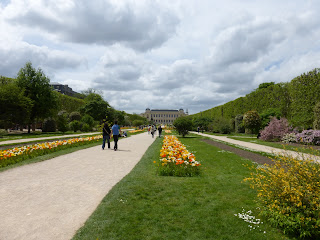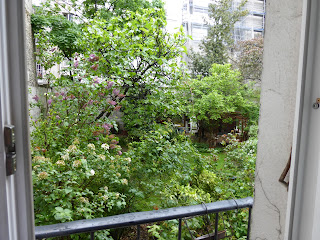Life Among the Super Rich
As I mentioned in an earlier blog post, I lived in Paris during the summer of 1969, just after graduating from college. I put an ad in the International Herald Tribune seeking an au pair position as a first step toward finding a "real" job once I got to Paris. I received about a dozen responses to my ad...some from American families (business and government ex-patriates and military families), as well as a number of French families. I surveyed the options, and chose the family with the best address, the fewest children to look after, and the highest salary! This eventually brought me to the doorstep of Mme Andrea Milos Frottier, 5 Villa Said (on the Avenue Foch), and her 10 year old daughter Caroline in early June.
I had made my way from the airport to the 16e arrondissement of Paris, a beautiful and very high class residential part of the city. Avenue Foch is a grand boulevard which emanates from the Place de l'Etoile (l'Arc de Triomphe) and is lined with Haussmanian edifices that housed, among others, Jacqueline Kennedy Onassis and Princesse Caroline of Monaco.
As I entered the gates of a cul de sac named Villa Said, I looked for #5 and found it quickly. Above the double door, an official sign from the Paris historical society noted that this had once been the residence of Anatole France, a noted novelist of the 19th century.
I rang the doorbell, and soon the small door at the side (a service entrance) opened. A Portuguese house maid and a very large dog greeted me. In heavily accented French, she invited me into the ground level of what turned out to be a 5 story town house (with an elevator, thank goodness). Maria told me that Madame and Monsieur were in London and would return the next day. Caroline was still at school. Meanwhile, my predecessor, a German girl, seemed to be in a hurry to leave. Eager to learn more about this family, I persuaded her to first brief me on the family before heading for the train station.
Apparently Madame was Hungarian nobility, her family having escaped from Budapest during the Revolution of 1956 with little more than the family jewels. She lived for a time in Switzerland, briefly married, divorced, and married again to Pierre Frottier and moved to Paris. They had a 10 year old daughter Caroline, but were in the midst of a messy divorce. Meanwhile, a handsome Italian playboy Gianni Tosetti had moved in to the townhouse in the Villa Said.
Sound like a soap opera? Just wait. It gets better (or rather worse)!
Unfortunately my pictures of this "family' are packed away in my stored belongings but I was able to locate a picture of Mr. Tosetti on the internet with his pal the Italian Duc d'Aoste. Tosetti is on the left.
Caroline was the quintessential "poor little rich girl," neglected by her socialite mother and raised by a succession of nannies, governesses, and au pairs. Starved for affection, she proved problematic from the first moment we met. I took a brief nap before her return from school and was awakened by the double doors to a guest room bursting open. The ten year old, hands on hips, stared at me. I struggled to my feet, introduced myself in French, to which she replied "Oh don't bother....I speak perfectly good English (delivered with a British accent, no less!)."
The evening went downhill from there as I tried to establish some sort of rapport with her. House rules, communicated to me by the German au pair, dictated a bath and bedtime by 9 pm. Madame's bathroom was off limits since Caroline had her own. However, I lost the first battle of wills as she ran and locked herself in her mother's bathroom and turned on the water. Minutes later she burst into the salon, holding a faucet knob in her hand and wailing that the tub was overflowing. I plunged my arm into the water, releasing the plug, and screwed the faucet back on the wall and turned off the water, but not before the pink carpet was soaked. Thus began my tenure chez la famille Frottier.
The following day, Madame (Frottier) and Monsieur (Tosetti) returned from London and the four of us had dinner in the dining room. The Portuguese maid, cook, and driver took their meals in the kitchen.
During the course of that dinner, Madame asked if I had a driver's license which of course I did. Apparently, in addition to the Bentley, the family kept a small Fiat as a vehicle to get Caroline from school to her various lessons. Unfortunately, it was a standard transmission and I did not know how to drive such a car. No problem, said Mr. Tosetti, I'll teach you.
So at 9:30 at night, I climbed into the tiniest car I had ever seen with an Italian guy whose French was no better than mine. Unfortunately, my vocabulary didn't include the words for ignition, steering wheel, shift, brakes, gears, clutch, etc. The next fifteen minutes in Paris traffic were enough to convince Monsieur and Madame that perhaps Caroline could be shuttled about the city via Metro.
Madame was 32 years old and quite beautiful in an aristocratic and very unapproachable way. The word "imperious" comes to mind. She told me she was an editor for Vogue but she did not seem to hold a real job in the sense of going to work from 9 to 5. Instead she and Mr. Tosetti were dressed in designer gown and tux nearly every evening of the week, disappearing around 9 pm and returning in the wee hours. (No wonder they needed an au pair!) They were clearly part of Paris society and were out "being seen" every night, which is arguably one of the obligations of those in the haute couture fashion industry. They often hosted dinners at home, welcoming well known names such as writer Francoise Sagan and the Rothschild's. I wasn't included in these soirees of course. My role was merely to keep Caroline out of the way and entertained.
To say the least, Madame was unlike anyone I had ever met in my life and I observed her with fascination, if not an element of fear. Indeed this Devil didn't wear Prada....but she did wear Marc Bohan and Nina Ricci.
By the end of the summer, I had given up on ever landing a "real" job in Paris. I didn't have a work visa, and had no appreciable professional skills that were currently in demand. Since I certainly didn't aspire to a career as an au pair, I headed back to the US. I reflected on this experience many times over the years, and was grateful for this glimpse into a world I might never have otherwise experienced. However, I never once envied the wealth and excess that I witnessed over those months. The image that stuck with me was that of emptiness, loneliness, and total lack of purpose to their glamorous lives...not to mention the inevitable collateral damage of parental indifference to little Caroline.
People often ask if I stayed in touch with Madame or Caroline. No, that was not going to happen. I was just another in a long line of household help with no special status or place in their lives. However a few years ago, I googled Caroline Frottier on the internet and found that she had graduated from the Lycee Francaise in New York City. I don't know how she got there or where she is now (now 54 years old!), but found that bit of information quite interesting.
It prompted me to begin researching what happened to Madame this past week...and I am still reeling from the shocking turns her life took over the years that followed my departure from Paris. Love affairs, multiple marriages, scandals, and even a world famous murder trial marked this woman's extraordinary yet sad life.
Stay tuned for the next installment: Whatever Happened to Andrea Milos Frottier? You will be amazed!







































